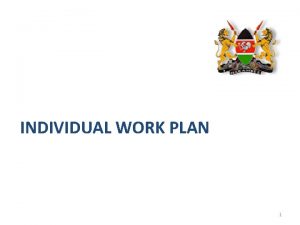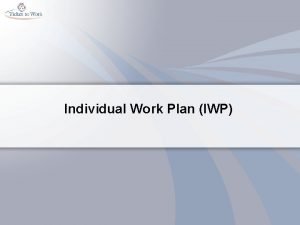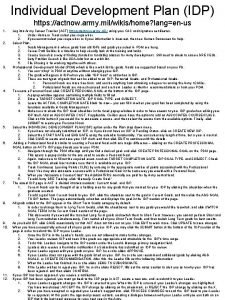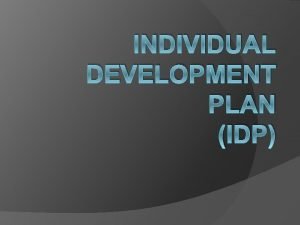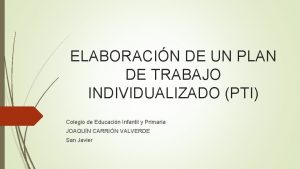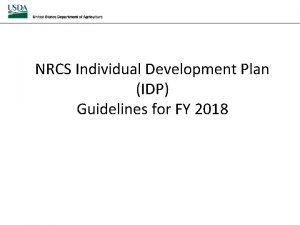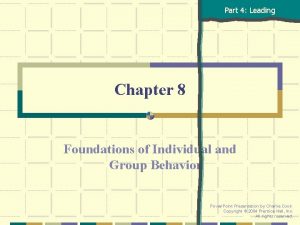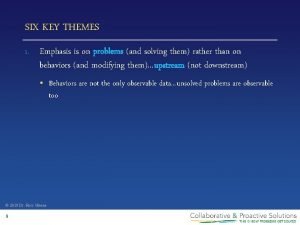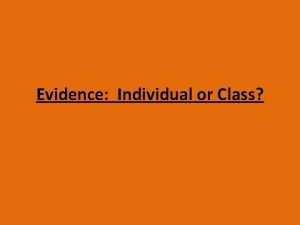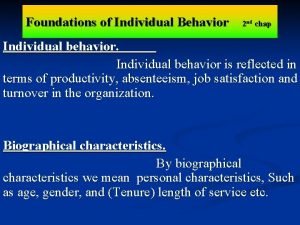INDIVIDUAL WORK PLAN 1 What is a work














- Slides: 14

INDIVIDUAL WORK PLAN 1

What is a work plan? A work plan translates the strategic objectives of an organization into specific activities and tasks to be undertaken by an employee or a team of staff over a given period. A work plan further indicates what is to be achieved at different stages of the plan implementation period given available resources. 2

Specific advantages of a work plan include: q Breaks activities into tasks to be performed by individual staff q Indicates when specific tasks are to be undertaken q Indicates specific resource requirements q Enables open and objective appraisal/evaluation to be undertaken 3

Linkage in work Planning/”Line of Sight” National Goals (Medium Term Plan) Ministry Mandate Strategic Plan Performance Contract * Service Charters 4

Annual Work Plan Departmental Work Plan Individual Performance Agreement (Target Setting) Quarterly Reports Evaluation Rewards/Sanctions/other interventions 5

Note: q Observance of the linkage is critical in work planning, setting of performance targets and performance evaluation q Work schedules can assist in preparation of individual work plans q Individual work plans help in setting S. M. A. R. T performance targets q Clear tasks allocation/job description is necessary in work planning 6

INDIVIDUAL WORK PLAN NAME OF OFFICER ………………………………. . P/NO………………………. . DESIGNATION: ……………………. . . . ASSIGNMENT PERIOD: ……………………………. PERFORMANCE OBJECTIVE DEPARMENT TASK DECRIPTION RESOURCES REQUIRED EXPECTED RESULTS TIME FRAME (BY WHEN) PERFORMANCE INDICATORS INDIVIDUAL 7

SETTING PERFORMANCE TARGETS 8

These must be generated from an individual work plan for effective completion of section 3 of GP 247 A(Revised 2008) and GP 247 B What is a target? Specifies in an overall objective to be achieved. The overall purpose can be broken down into the things that can be done in order to achieve it. These usually have shorter and definitive time horizon and/or some measurable element. Targets are specific to job holders in an organization. 9

Bad targets are generalizations and platitudes that are hard to pinpoint or realize or cast in non specific phrases such as Improve efficiency Maximize efficiency Increase profits unless clarified by what percentage Maximize quality Increase market share – unless percentage of increase is given Improve customer service Improve service delivery Lower production costs – unless percentage of lowering cost is given Stream line procedures – unless an indication of how the streamlining is to be achieved is given q Improve communication q Better if timeline, quantities, percentages or quotas are included to be specific and distinct from outcomes. q q q q q 10

S. M. A. R. T targets must be; - q. S – Specific Words, which express vagueness rather than concrete results, should be avoided q M – Measurable Targets give you something to aim for. They incorporate recognizable standards of measure of performance which are objectively clear to everyone involved. There is no job even the most repetitive whose results cannot be measured. Some common measures include; Numeric, like units processed Financial, like costs and margins Deadlines like delivery and completion dates Positive, negative feedback like complaints/rejects obtained from surveys and collated 11

q A – Agreed The best way to secure commitment in achieving of targets is by full participation in the setting of targets by those responsible for implementing them. Targets are set by an appraisee in consultation with the supervisor. Individuals at any level cannot be left alone to decide their targets for avoidance of setting soft or nonachievable targets. It is the supervisor’s responsibility to guide on achievement of the end result while the appraise is responsible for the details of how the result is to be achieved. q. R – Realistic targets acknowledge opportunities, constraints, changing circumstances and are achievable. They are within the scope of what can and is to be done. They aim at continuous improvement and should be challenging q T – Time bound Effective targets have schedules and time frames which are the basis of action planning. Timelines are essential in setting targets and guide towards achieving them as scheduled. Timeframes are essential features in work planning. Timeframes assist in monitoring through periodic reviews and evaluating progression in target achieving. They also motivate individuals to get the job done. 12

In PAS GP 247 A (Revised 2008) and GP 247 B targets should be; q Crafted short and simple q Results based q Targets must be discussed and agreed between supervisor and appraisee being supervised q Targets must feed into departmental and ministerial targets/objectives q Targets should range from FIVE to SEVEN at most for them to be realistic and achievable. q 13

Making your Action Plans work! 14
 Individual workplan
Individual workplan Components of individual work plan
Components of individual work plan Formato plan de carrera
Formato plan de carrera Individual service plan mental health example
Individual service plan mental health example Army idp
Army idp Idp examples
Idp examples Air force individual development plan
Air force individual development plan Pti colegio
Pti colegio Plan de desarrollo individual
Plan de desarrollo individual Individual education plan
Individual education plan Individual development plan template
Individual development plan template Institucion educativa maestro pedro nel gomez
Institucion educativa maestro pedro nel gomez Alsup ross greene
Alsup ross greene Place/location/destination plan a
Place/location/destination plan a Long term plan and short term plan
Long term plan and short term plan
